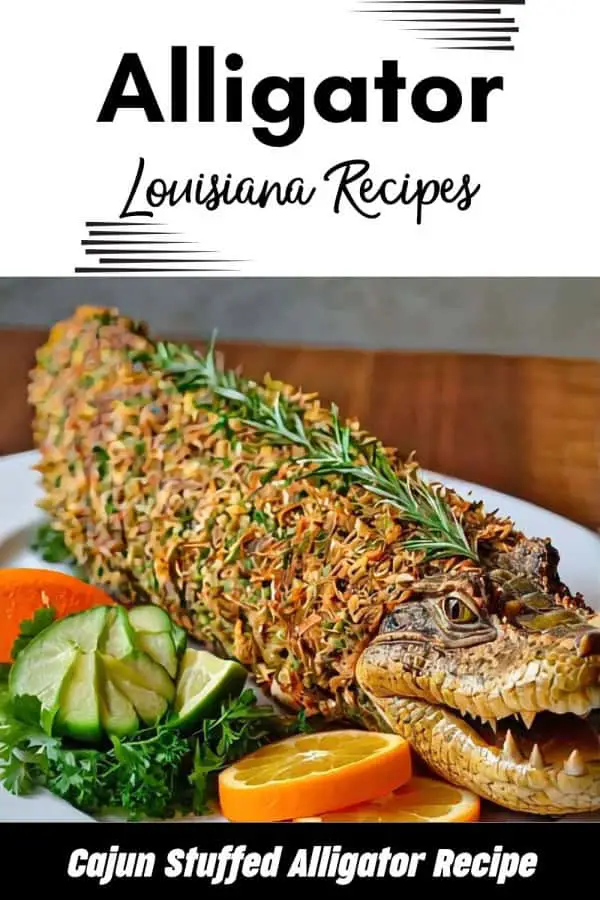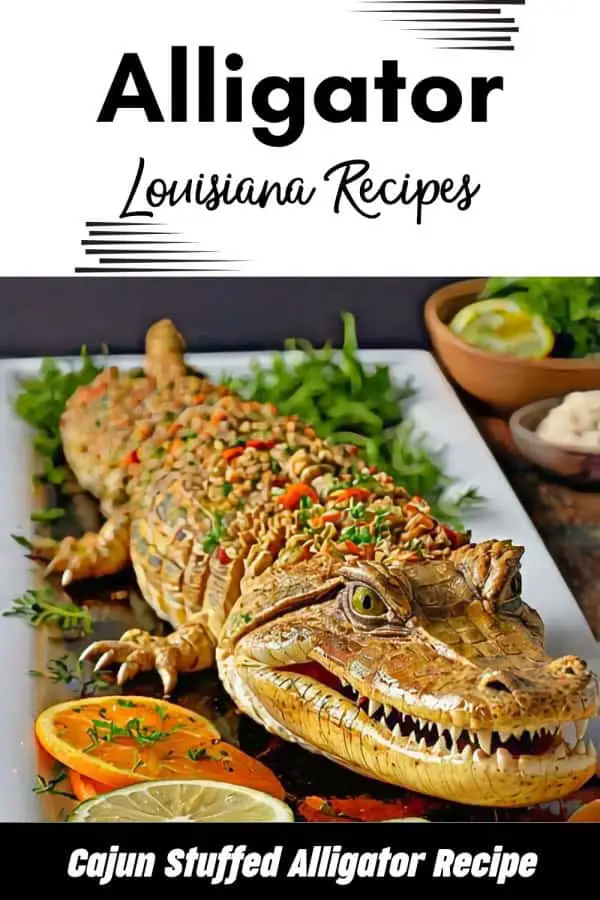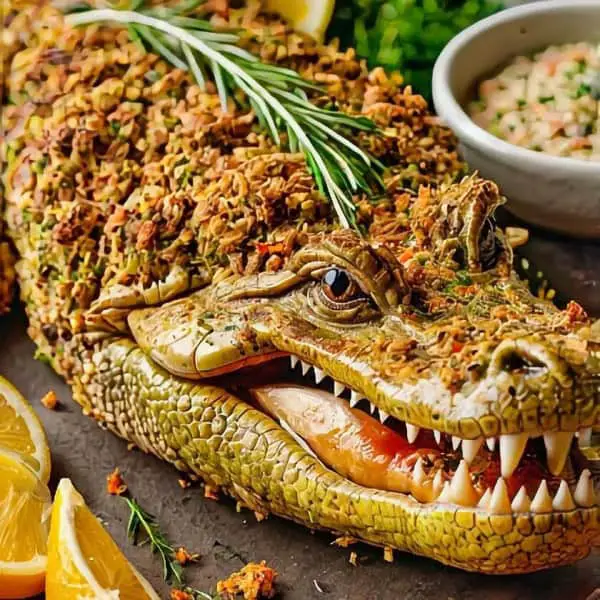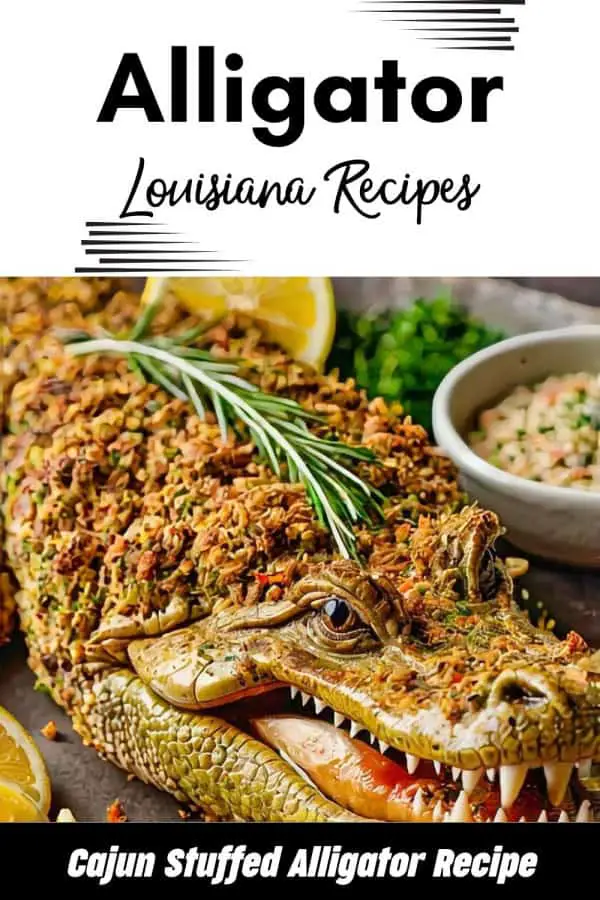When I tried Cajun Stuffed Alligator, the presentation was truly unforgettable. The alligator, roasted to a rich, golden-brown, had a perfectly crisped skin that crackled when cut. What caught my eye was the vibrant stuffing, which peeked through the openings in the alligator’s skin, adding a burst of colour and texture. The meat underneath was tender and juicy, contrasting beautifully with the crispy exterior. This dish not only looked spectacular but also captured the bold, spicy essence of Cajun cuisine in a stunning way.
During our trip, we had the chance to try the Cajun Stuffed Alligator Recipe, a unique dish that highlighted a blend of Southern and local flavours. The restaurant, known for its innovative approach to traditional dishes, offered us a chance to experience this unusual recipe. We enjoyed the relaxed setting, which made the tasting experience even more enjoyable.
The Cajun Stuffed Alligator Recipe was presented with care. The dish featured a whole alligator stuffed with a seasoned filling, which was clearly visible on the plate. The appearance of the Cajun Stuffed Alligator Recipe was striking, showcasing the alligator’s distinctive presentation. The cooking method ensured the dish was both visually appealing and flavourful.
We were pleased to receive the Cajun Stuffed Alligator Recipe to take home. This allowed us to recreate the dish and relive the experience from our trip. Bringing the recipe back with us added a special touch to our culinary adventures and allowed us to enjoy a taste of our travels in our own kitchen.
Ingredients For the Cajun Stuffed Alligator Recipe
Alligator
Sweet Onion
Green Bell Pepper
Stalks of Celery
Carrots
Cleaned Crawfish Tails
Cajun Andouille Sausage
Cornbread Stuffing
Cajun/Creole Seasonings
Hot Sauce
Favorite Bourbon
Cooking Instructions For the Cajun Stuffed Alligator Recipe
- Begin by preparing the alligator meat: Rinse the 3 lbs of alligator meat thoroughly under cold water. Pat it dry with paper towels. Cut the alligator meat into 3 inch cubes and put a slit in each for the stuffing mix. Season the meat with Cajun/Creole seasonings to taste. Set aside the seasoned alligator meat.
- Prepare the vegetables: Dice 1 large sweet onion. Dice 1 large green bell pepper. Slice 3 stalks of celery. Peel and dice 4 Carrots. Set aside the diced vegetables.
- Prepare the stuffing mixture: In a large bowl, combine 1 lb of cleaned crawfish tails and 1/2 lb of Cajun Andouille sausage (sliced into small pieces). Add your favorite cornbread stuffing to the mixture. Season the stuffing mixture with Cajun/Creole seasonings to taste. Mix everything together thoroughly. Set aside the stuffing mixture.
- Assemble the stuffed alligator: Take a piece of seasoned alligator meat and stuff it with a spoonful of the stuffing mixture. Secure the stuffed alligator meat with toothpicks to keep it closed. Repeat this process for all the alligator pieces. Set the stuffed alligator pieces aside.
- Prepare the cooking sauce: In a separate bowl, mix Louisiana Crawfish Co. Hot Sauce and 2 oz. of your favorite bourbon. Stir until well combined.
- Cook the stuffed alligator: Heat a large skillet or frying pan over medium-high heat. Add a small amount of oil to the pan. Carefully place the stuffed alligator pieces in the hot pan. Cook until the alligator is browned on all sides and cooked through, about 5-7 minutes per side. Pour the prepared cooking sauce over the stuffed alligator. Reduce the heat to low, cover, and simmer for an additional 10 minutes, allowing the flavors to meld.

5 Health Benefits of Eating Alligator
Alligator meat offers several health benefits, making it an excellent protein choice. Here are five key advantages of including alligator in your diet:
1. Lean Protein: Alligator meat is exceptionally lean, making it lower in fat compared to other meats like beef or pork. This can help reduce overall fat intake while still providing high-quality protein, essential for muscle growth and repair.
2. Low Cholesterol: Alligator contains less cholesterol than many other meats, making it a heart-healthy option. Lower cholesterol levels help support cardiovascular health, reducing the risk of heart disease.
3. Rich in Omega-3 Fatty Acids: Alligator meat provides a good source of omega-3 fatty acids, which are known for their anti-inflammatory properties. Omega-3s support heart health, improve brain function, and reduce inflammation in the body.
4. High in Vitamins and Minerals: Alligator meat is rich in essential nutrients like potassium, iron, and niacin. These vitamins and minerals are vital for maintaining energy levels, promoting healthy blood circulation, and supporting overall bodily functions.
Sustanaility of Alligator Meat
The sustainability of alligator meat is an important factor in its growing popularity. Alligators, once endangered, have made a strong comeback due to successful conservation efforts and regulated farming practices. In the U.S., particularly in states like Louisiana and Florida, alligator farming is strictly regulated to ensure healthy populations and prevent overharvesting. This makes alligator meat a sustainable choice for those looking for an alternative protein source.
Farmed alligators are raised in environments that replicate their natural habitat, but with added oversight to ensure humane and eco-friendly practices. The meat is harvested without harming wild populations, which helps maintain the delicate balance in local ecosystems. Additionally, many parts of the alligator, including its skin, are used for leather goods, making the farming process efficient with minimal waste.
Sustainably sourced alligator meat also supports local economies, especially in regions where farming and harvesting are a cultural tradition. By buying farmed alligator, consumers are contributing to ongoing conservation efforts while enjoying a unique, lean protein.
In summary, the sustainability of alligator meat comes from responsible farming and regulation, helping to protect wild populations and providing an eco-friendly food source that supports both the environment and local economies.
When selecting the best alligator meat, several factors come into play. The most tender and flavorful cuts generally come from the tail, which is often considered the best choice. The tail meat is white and has a texture similar to veal or chicken, making it highly versatile for various recipes. It’s lean and mildly flavored, perfect for grilling, frying, or using in stews.
Other cuts, like the legs, are a bit tougher and more suited for dishes that require slow cooking or braising. These cuts are often darker and have a gamier taste, making them ideal for rich gumbos or jambalayas.
When purchasing alligator, it’s important to look for sustainably farmed options, as wild alligator can have inconsistent quality due to diet and habitat. Ensure the meat is fresh or properly frozen, as this affects the overall taste and texture.
In terms of preparation, marinating the alligator tail can help tenderize it and add flavor. Overall, the best alligator choice depends on the dish you’re preparing, but the tail meat remains a top favorite due to its tenderness and adaptability across various cooking methods.
Why I Love Cooking Alligator Recipes
Cooking alligator recipes is a unique experience that brings a sense of excitement to the kitchen. One of the reasons I enjoy it so much is the versatility of alligator meat, especially the tail, which has a mild flavor and a texture similar to chicken or veal. This makes it perfect for grilling, frying, or incorporating into dishes like gumbo or jambalaya.
Another reason I love cooking alligator is the challenge it presents. Alligator meat is lean and can be tricky to cook just right, which pushes me to experiment with different methods and seasonings. Whether I’m grilling alligator steaks or frying bites for a party appetizer, it always brings out my creative side.
Additionally, alligator recipes have a novelty factor, impressing guests with a dish that’s far from ordinary. It’s always fun to see their reactions when they try alligator for the first time, especially when prepared well.
Lastly, cooking alligator connects me to the southern traditions where it’s a common ingredient in regional cuisine. It allows me to explore new flavors and techniques while also paying homage to classic recipes from the Gulf Coast. Cooking alligator has become a flavorful, creative adventure in my kitchen.

FAQ For the Cajun Stuffed Alligator Recipe
Q: What is the Cajun stuffed Alligator recipe?
A: The Cajun stuffed Alligator recipe involves filling an alligator carcass with a Cajun-seasoned stuffing mixture, then cooking it to create a flavorful and unique dish.
2. What ingredients are needed for the Cajun stuffed Alligator recipe?
A: The Cajun stuffed Alligator recipe typically includes an alligator carcass, a stuffing mixture with Cajun spices, breadcrumbs, vegetables like bell peppers and onions, and sometimes sausage or seafood.
3. How do you prepare the Cajun stuffed Alligator recipe?
A: To prepare the Cajun stuffed Alligator recipe, prepare the stuffing with Cajun spices, stuff the alligator carcass with the mixture, then roast or grill it until fully cooked and the meat is tender.
4. Can you use different types of stuffing in the Cajun stuffed Alligator recipe?
A: Yes, you can use different types of stuffing in the Cajun stuffed Alligator recipe, such as adding sausage, seafood, or varying the spices to adjust the flavour to your preference.
5. What can you serve with the Cajun stuffed Alligator recipe?
A: The Cajun stuffed Alligator recipe pairs well with sides like rice, collard greens, or cornbread, and can be complemented by a tangy dipping sauce or a fresh salad.

Cajun Stuffed Alligator Recipe
Equipment
- Large skillet or frying pan
- Mixing Bowls
- Toothpicks
- cutting board
- Knife
- Spoon for stuffing
Ingredients
- 3 lbs Alligator
- 1 Onion Large Sweet
- 1 Green Bell Pepper Large
- 3 Stalks Celery
- 4 Carrots
- 1 lb Crawfish Cleaned Tails
- 1/2 lb Andouille Sausage
- Your favorite Cornbread Stuffing
- Cajun/Creole Seasonings to Taste
- Louisiana Crawfish Co. Hot Sauce
- 2 Oz. of your Favorite Bourbon Your Favorite
Instructions
Begin by preparing the alligator meat:
- a. Rinse the 3 lbs of alligator meat thoroughly under cold water.
- b. Pat it dry with paper towels.
- c. Cut the alligator meat into 3 inch cubes and put a slit in each for the stuffing mix.
- d. Season the meat with Cajun/Creole seasonings to taste.
- e. Set aside the seasoned alligator meat.
Prepare the vegetables:
- a. Dice 1 large sweet onion.
- b. Dice 1 large green bell pepper.
- c. Slice 3 stalks of celery.
- d. Peel and dice 4 carrots.
- e. Set aside the diced vegetables.
Prepare the stuffing mixture:
- a. In a large bowl, combine 1 lb of cleaned crawfish tails and 1/2 lb of Cajun Andouille sausage (sliced into small pieces).
- b. Add your favorite cornbread stuffing to the mixture.
- c. Season the stuffing mixture with Cajun/Creole seasonings to taste.
- d. Mix everything together thoroughly.
- e. Set aside the stuffing mixture.
Assemble the stuffed alligator:
- a. Take a piece of seasoned alligator meat and stuff it with a spoonful of the stuffing mixture.
- b. Secure the stuffed alligator meat with toothpicks to keep it closed.
- c. Repeat this process for all the alligator pieces.
- d. Set the stuffed alligator pieces aside.
Prepare the cooking sauce:
- a. In a separate bowl, mix Louisiana Crawfish Co. Hot Sauce and 2 oz. of your favorite bourbon.
- b. Stir until well combined.
Cook the stuffed alligator:
- a. Heat a large skillet or frying pan over medium-high heat.
- b. Add a small amount of oil to the pan.
- c. Carefully place the stuffed alligator pieces in the hot pan.
- d. Cook until the alligator is browned on all sides and cooked through, about 5-7 minutes per side.
- e. Pour the prepared cooking sauce over the stuffed alligator.
- f. Reduce the heat to low, cover, and simmer for an additional 10 minutes, allowing the flavors to meld.



4 comments
This turned out well. It reminded me of stuffed turkey but the Alligator was not as dry. Thank you for the recipe.
I never thought Id see a recipe for stuffed alligator! But hey, the health benefits and sustainability angle are interesting. Would you try it? I might just have to give it a go!
I never thought Id consider eating alligator, but those health benefits are intriguing! Who wouldve guessed its sustainable too? I might just have to give this Cajun Stuffed Alligator Recipe a try.
I never thought Id see a recipe for Cajun Stuffed Alligator! But hey, if its sustainable and has health benefits, why not give it a try? Whos up for a wild cooking adventure? 🐊🔥
Comments are closed.